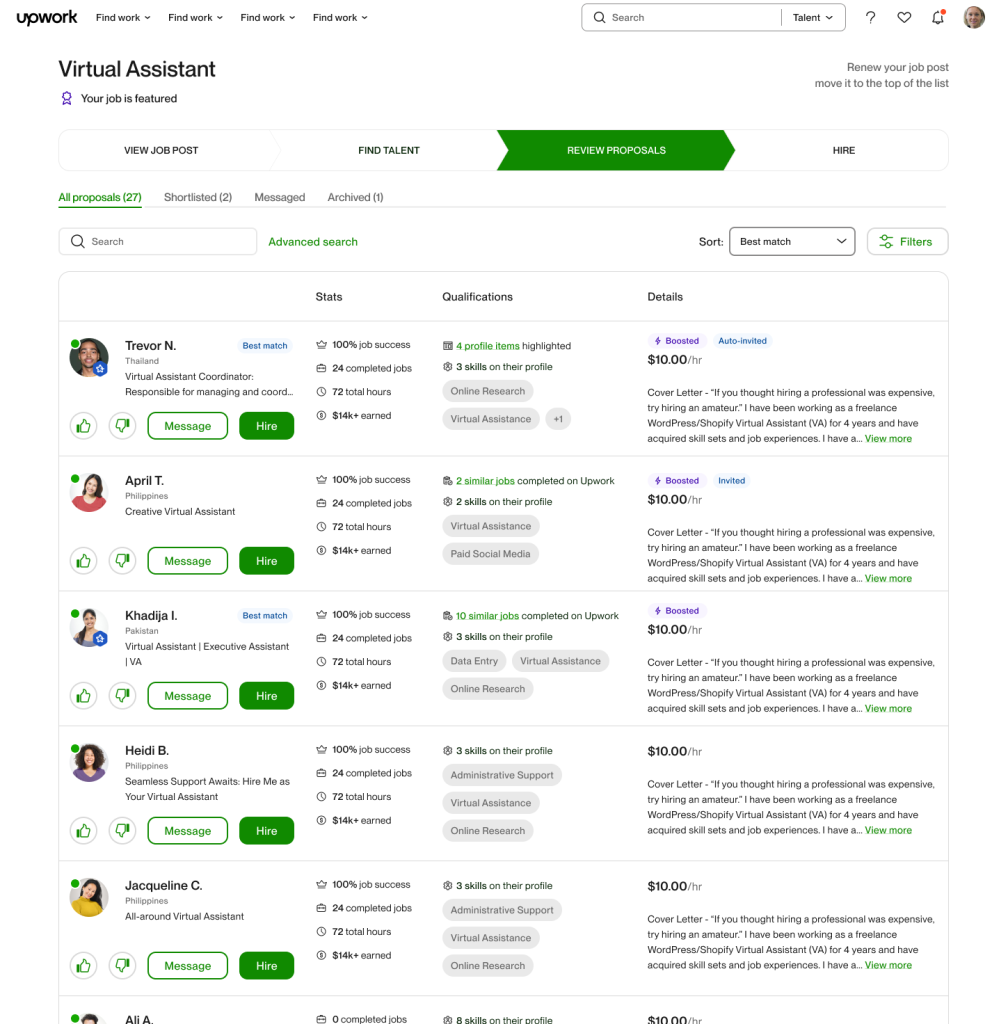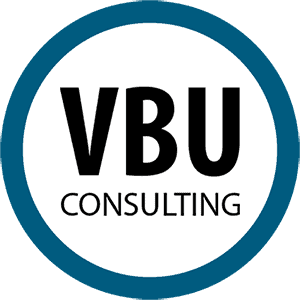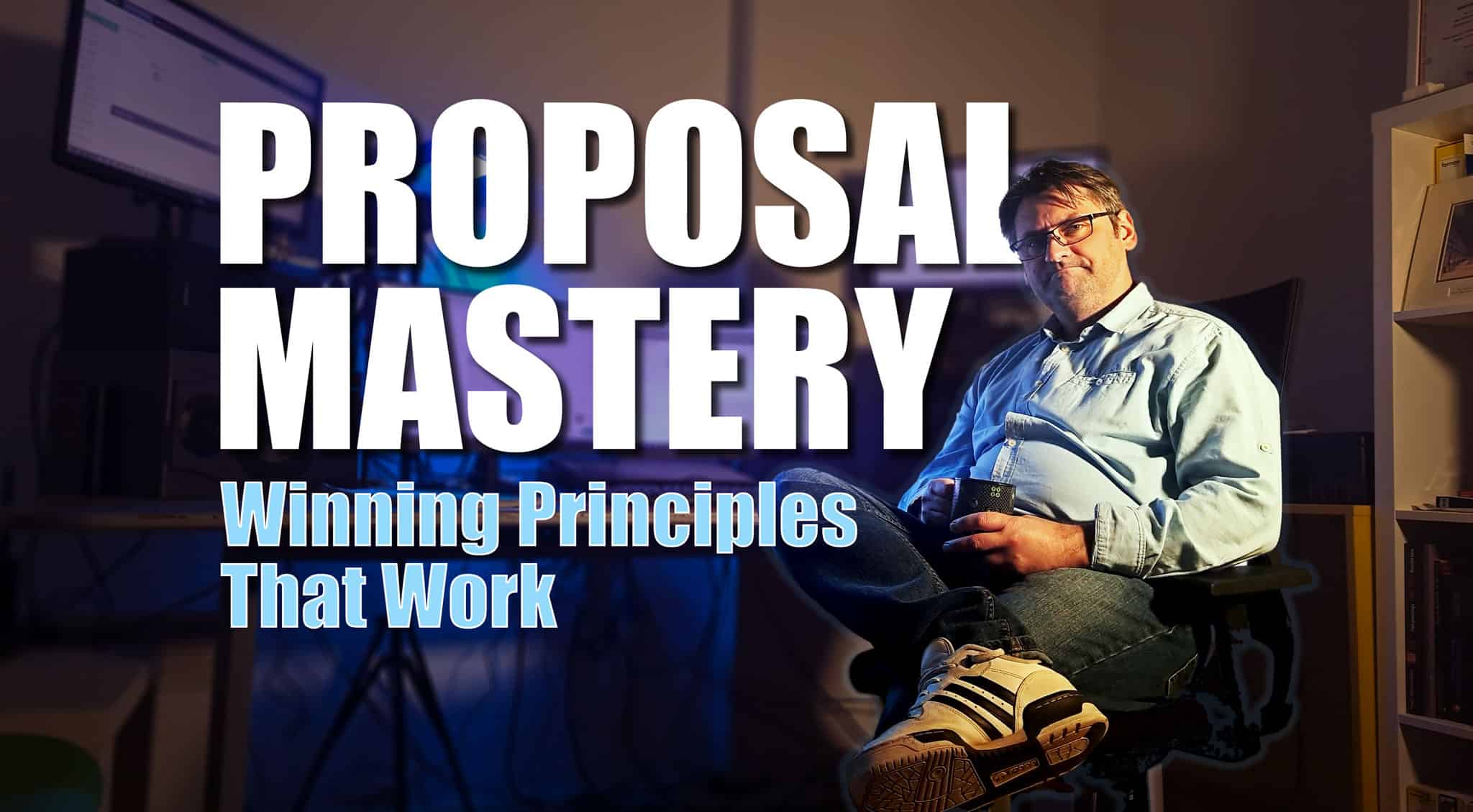You sent a proposal on the Upwork freelance platform, and there has been no reply. That’s a common scenario that every freelancer faces when bidding on Upwork – one of the most popular, if not the most popular, freelancing platforms in the world. And that’s not unusual. Winning a job on Upwork, and not only on Upwork, doesn’t depend solely on you, your experience, professionalism, and the quality of your Upwork profile, as well as whether your proposal is the cheapest one. It’s a complex vector of various attributes, with you and your activities being only part of it. But what you can do is to master creating an Upwork proposal.
Upwork is an oversaturated pool of freelancers competing for jobs. The prospects (read potential clients – Upwork clients) are often not ready to review over 100 proposals (50+ submitted via Upwork, 50+ submitted outside (email) of Upwork, and a few more phone calls).
Reaching an equilibrium with a prospect is more art than a science. However, what I can do to help you is to think loudly in this article and blend my experience into it. Although I mentioned that this article focuses on principles that are channel-agnostic, it also incorporates flavors for proposals submitted via Upwork. Also, I use examples in the context of a call for project management services.
Two things: trust and people are those who sell.
Table of Contents
The Foundation: Understanding Trust-Building Psychology
Building instant trust begins with understanding the client’s decision-making psychology. Reading from various sales experts, client development specialists, and psychologists working in a great HR team that can be found online shows that prospects and clients form judgments about proposals within the first 30 seconds. I experienced the same when I wore a hat of a client who was looking for a service on Upwork. I was overwhelmed with over 100 proposals, and I was looking for a hook in each proposal that didn’t even last 30 seconds.
Even for experienced professionals with 50+ successful jobs and a six-figure income, this creates both an advantage and a challenge – they need to leverage their credibility while ensuring every proposal feels fresh and personalized.
The Core Trust Equation: Trust = Credibility + Reliability + Intimacy - Self-Orientation Your extensive track record provides credibility, but each proposal must demonstrate reliability (understanding their specific needs), intimacy (speaking their language), and minimal self-orientation (focusing on their success, not your achievements).
Strategic Approach: The IMPACT Method
Let’s outline the individual elements that align with established principles of copywriting and proposal writing that will give your proposal more chances to win. (NOTE: Don’t be confused with other known frameworks with the same name.)
I – Immediate Attention Hook
Your opening line must demonstrate a specific understanding of their business challenge. This is a core principle in copywriting, extensively covered in attention-grabbing frameworks.
Poor Opening: “I am writing to express interest in your project.”
Winning Opening: “I’ve helped 3 SaaS startups increase project delivery speed by 45% using similar agile frameworks to what you’re describing.”
M – Mirror Their Language
Use psychological mirroring by incorporating the client’s exact terminology and pain points. This fosters subconscious alignment and demonstrates a profound understanding of the subject matter. At the end of the day, it’s common sense that things will go more easily if you speak the same language and use the same terminology.
Implementation: Extract 3-4 key phrases specific to their needs/pain from their job post and weave them naturally into your response. If they mention “scalable architecture,” use that exact phrase rather than “flexible system design.”
PRO Tip: Sometimes, prospects may not be familiar with topics as you are, being a professional in the field. Usually, you will have a much precise and suitable phrase or term that pinpoints the key part of their needs and pain that the prospect is not familiar with, providing a single-sentence explanation or simply adapting to their terminology even though you know there are suitable or even more correct phrases. It’s essential that your wording resonates with the prospect, rather than using more accurate and proper words.
P – Proof Through Specificity
Generic experience claims create skepticism, aversion, even frustration. Instead, provide micro-case studies with measurable outcomes.
Generic: “I have 5 years of project management experience.”
Specific: “My last PM project delivered a $2.3M software rollout 3 weeks early and 12% under budget using hybrid agile methodologies.”
A – Address Unstated Concerns
Experienced clients have hidden fears beyond the obvious project requirements. Address these proactively:
- Risk Management: “I maintain detailed risk registers and have contingency plans for the 5 most common software project pitfalls.”
- Communication: “You’ll receive automated weekly progress dashboards.”
- Quality Assurance: “All deliverables go through my 7-point validation process before client review.”
C – Compelling Next Step
End with a specific, low-commitment call-to-action that moves the conversation forward.
Weak CTA: “Looking forward to hearing from you.”
Strong CTA: “I’m available for a 15-minute call tomorrow at 2pm EST to discuss your timeline and answer any questions about the hybrid agile approach.”
T – Tailored Value Proposition
Your unique value must be crystal clear and directly tied to their business outcome. You can help yourself with this part by answering a question: “Why is your service the best solution for the prospect’s needs?”
Advanced Psychological Triggers
Social Proof Leveraging
Prepare your project portfolio to fit the wording and projects similar to those you tend to get, strategically reference similar client successes without breaking confidentiality:
“My Fortune 500 client (telecommunications industry) saw 40% faster deployment cycles after implementing the project framework I’d recommend for your situation.”
PRO Tip: You can use the Highlights section in your Upwork proposal to pinpoint the highly matching successful stories (completed jobs with positive clients’ feedback), especially if you have tens of sucessfuly completed jobs in which you provided different services than the one you offer in your proposal. Remember that saving and respecting time for the person representing the prospect is very important. Make their lives easier by providing them with quicker and easier access to valuable information. Don’t overkill your proposal by calling the prospect to view your profile and entire portfolio, as it includes 50+ projects/case studies that correspond to only 5% of the job call requirements.
PRO Tip: Throughout my career, I have had the pleasure of working with Smiljka Shoshkoska Gjorgjieva, a psychologist and MSc in Human Resources Management, as well as Group Head of Human Capital Management at G+D Netcetera. She confirmed that during the hiring process of a future employee, contractor, or fractional professional, HR professionals pay close attention to the candidate’s portfolio, looking for their experience and skills in the context of a real job, and primarily in the same business domain and industry.

Future Pacing Technique
Create positive mental imagery of project success:
“Three months from now, your development team will be delivering features 35% faster while your stakeholders receive automated status updates that keep everyone aligned, no more chasing for project updates.”
Authority Through Methodology
Establish expertise by referencing your structured approach.
“I use my proven Project Success Framework™: Requirements clarity sessions, risk-weighted milestone mapping, and automated progress tracking that prevented scope creep on my last 12 projects.”
PRO Tip: Double-check the job description and skills/tags attached to the call to recognize terms related to working methodology, and emphasize them in your description of your working process. For instance, if they included “project planning” as a tag for the call, then on your end, it should ring a bell that you should emphasize that aspect of the structured working approach in your proposal.
Proposal Structure Optimization
The 150-Word Rule
I’ve been reading from various sources that indicate the optimal proposal length is between 150 and 250 words. Additionally, modern life is fast-paced, and saving time is crucial on both sides of the equation. Your extensive experience enables you to convey information concisely while demonstrating expertise.
Still, I do love to apply an active listening approach when writing a proposal, meaning first listen, then talk, which translates into reading and understanding the job description, and then writing your reply/proposal.
PRO Tip: Read the job description’s formatting, not just its semantics. A short job description might mean that the other side didn’t have much time to write a nice and descriptive call. Maybe the job offerer will not have time to read a long proposal. Or, perhaps that should give you a hint that the prospect is always in a hurry, might lack in his response when you need it, and not provide feedback and requirements that are mandatory for you to deliver. Try to read between the lines, and consider not only the semantics of the job description but also its format.
Strategic Questioning
Ask 1-2 insightful questions that showcase your expertise:
“Have you considered implementing staged rollouts for user acceptance testing? This approach typically reduces post-launch issues by 60% based on my experience with similar projects.”
Risk-Reversal Statements
Address client fears directly:
“If we’re not seeing measurable progress improvements by the 3-week checkpoint, I’ll adjust the methodology at no additional cost.”
Industry-Specific Positioning
As an expert expert in the domain/field, emphasize outcomes that matter most to your target clients:
For Startups
- Speed to market acceleration
- Resource optimization
- Technical debt prevention
For Enterprises
- Risk mitigation frameworks
- Compliance management
- Cross-team coordination excellence
For Scale-ups
- Process scalability
- Team productivity optimization
- Quality assurance systems
Response Rate Maximization Tactics
The 15-Second Test
Structure proposals so key information is digestible within 15 seconds:
- Hook (one line)
- Relevant experience (one specific example)
- Unique approach (one methodology mention)
- Next step (one clear action)
PRO Tip: When a prospect (Upwork client) reviews received proposals, the main feature displays a list of proposals along with some key information about the senders. Besides the general information about the freelancers’ profiles, the prospect can view the first ~160 chars of your cover letter. Don’t waste those precious 160 characters by being friendly and formal, starting with an intro like “Dear job offer representative, I would like to express my interest in your call, because I believe I’m a good fit…” Try to be creative and slam it with a 160-character-long hook that will tease the prospect (or his representative) to click on your proposal and see more details, and hopefully mark your proposal as shortlisted.

Competitive Differentiation
Avoid commoditizing yourself. Instead of listing services, highlight your unique process:
“Unlike traditional PM approaches, my Accelerated Delivery Method™ combines daily pulse checks with predictive risk modeling, the same approach that helped my fintech client launch 6 weeks ahead of schedule.”
Common Pitfalls to Avoid
It’s time to share some of the pitfalls you want to avoid when you prepare your Upwork proposal. In a nutshell, don’t send generic proposals, don’t underprice your level of skills and experience, don’t run to everything that shines, but choose a call that fits you very well, and track your performance so that you can learn something and improve your proposal in every single iteration. For all addressed pitfalls, some insights, and PRO tips, please continue reading.
Over-Credential Dumping
Your background should speak for itself through your profile. So, revise your profile once more and make an edit in the mentioned context. In proposals, focus on how your experience solves their specific challenge rather than listing achievements.
Insights: For some of my proposals, I have prospects who reply to my proposal even without visiting my profile. (I rely on the stats and trends reports from Upwork.)
Generic Templates
You might be tempted to use templates. Instead, create frameworks that you customize heavily for each client.
PRO Tip: Try to understand the culture and character of the prospect by reading his proposal carefully, so you can blend a writing style that the client easily understands. NOTE: This doesn’t mean you have to pretend to be someone you are not or lie.
Underpricing Your Expertise
Research shows that mid-range pricing often wins over lowest bids. Having an extensive portfolio allows you to position yourself at premium rates with confidence.
Strategic Opportunity Selection
Focus on projects where your specific expertise creates clear competitive advantage. Quality over quantity maximizes your time investment. It’s much better to post a quality proposal for a select one-call that fits your specific services carefuly, rather than posting tens of generic ones boosted with additional Connects, and then complain on the Upwork community on Reddit that you didn’t receive any response.
Proposal Performance Tracking
Monitor which elements generate responses:
- Opening hook variations
- Specific experience references
- Methodology mentions
- Call-to-action formats
This approach will help you create a unique framework that works best for you.
Continuous Refinement
Your extensive client feedback provides rich data for proposal optimization. Extract common themes from successful project outcomes to strengthen future proposals.
PRO Tip: A few of my clients told me that they rely on me. They know that the request they have will be done with a certain level of quality (no headaches for them). On one occasion, one of my friends, who worked as an operational manager in the gaming industry, told me that they had freelancers alongside their in-house team. They pay them very high rates, but he confirmed that he knows that the request sent to them will be delivered on time with a certain level of quality and without causing additional time and effort for him. Try to think about how you can incorporate “an extra mile” culture in your deliverables and services you provide to your clients, and then how you can present that value in your proposal.
Long-term Relationship Building
Position each proposal as the beginning of a potential long-term partnership:
“This initial project would be an excellent pilot for the comprehensive project optimization program I’ve developed for growing tech companies.”
Implementation Timeline
Here is a recommended simple 1-month plan for adjusting your approach to writing proposals and applying for jobs on Upwork. Of course, you can make your own plan, but be sure you have one and follow it.
Week 1: Audit your current proposal approach using this framework
Week 2: Create 3-5 customizable templates based on common client types
Week 3: Test new approaches with A/B variations
Week 4: Analyze results and refine based on response patterns
Over & Out

Your proven track record provides the credibility foundation, but implementing these psychological and structural optimizations will significantly increase your proposal conversion rates. The key is maintaining authenticity while strategically positioning your expertise to address each client’s specific concerns and aspirations.
Do the recommendations in the article guarantee that you will have a 10/10 score 100% of the time? Of course not. If it were an easy job, everyone would be a successful freelance professional. So, good luck! Let the best proposal win!
So, if you found this article helpful, you can always support my work by sharing it and buying me a coffee ☕ on Buy Me a Coffee. Your support keeps me motivated to keep sharing insights.
Recommended Resources
- Book: Remote Work Revolution: Succeeding from Anywhere By Tsedal Neeley (Professor and Chair of MBA Program at Harvard Business School)
The book provides practical methods for creating virtual teams and fostering trust-based, inclusive environments, as well as clear communication systems and effective solutions for resolving distributed work problems. However, in the context of the article, this book offers invaluable chapters that decompose trust as a psychological state, particularly immediate trust. Understanding instant or fast trust is highly relevant for bidding on Upwork or similar platforms. - How To Create a Proposal That Wins Jobs
This is a helpful article from another freelancer, Sean Cope, who built an SEO and content creation company by freelancing on Upwork.


1 thought on “Upwork Proposal Mastery: Principles That Work”
Comments are closed.